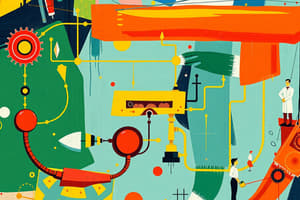Podcast
Questions and Answers
What best describes the forces that drive a system towards change?
What best describes the forces that drive a system towards change?
- Forces that support the current state
- Forces that facilitate change (correct)
- Forces that diminish motivation
- Forces that oppose new developments
Which of the following is NOT considered a restraining force?
Which of the following is NOT considered a restraining force?
- Lack of transportation
- Limited resources
- Family support (correct)
- Low energy
According to Lewin's rules, which of the following is an important aspect of implementing change?
According to Lewin's rules, which of the following is an important aspect of implementing change?
- Individuals affected by change should be excluded from planning
- Change should always be gradual and well-planned (correct)
- Change should only occur when individuals are ready
- Changes should be sudden and unexpected
What characterizes the 'Contemplation' stage of change?
What characterizes the 'Contemplation' stage of change?
Which of the following conditions can enhance the likelihood of successful change?
Which of the following conditions can enhance the likelihood of successful change?
What is the primary characteristic of planned change?
What is the primary characteristic of planned change?
During which stage of Kurt Lewin's Change Theory does the change agent convince group members of the need to change?
During which stage of Kurt Lewin's Change Theory does the change agent convince group members of the need to change?
What is NOT a quality of an effective change agent?
What is NOT a quality of an effective change agent?
What must a change agent ensure during the Movement stage of change?
What must a change agent ensure during the Movement stage of change?
Which statement accurately describes accidental change?
Which statement accurately describes accidental change?
What action should a change agent take during the Refreezing stage?
What action should a change agent take during the Refreezing stage?
Which of the following activities is NOT typically part of the Unfreezing stage?
Which of the following activities is NOT typically part of the Unfreezing stage?
What is crucial for a change agent to do to ensure successful change implementation?
What is crucial for a change agent to do to ensure successful change implementation?
What is one significant limitation of the organizational chart?
What is one significant limitation of the organizational chart?
Which organizational structure is characterized by a simplified hierarchy and increased decision-making authority?
Which organizational structure is characterized by a simplified hierarchy and increased decision-making authority?
What does a good organizational structure accomplish?
What does a good organizational structure accomplish?
In a matrix organizational structure, what is the primary focus?
In a matrix organizational structure, what is the primary focus?
Which of the following statements is true regarding authority and status in organizational charts?
Which of the following statements is true regarding authority and status in organizational charts?
What do rational-empirical strategies rely on when implementing change?
What do rational-empirical strategies rely on when implementing change?
Which characteristic is NOT typical of aged organizations?
Which characteristic is NOT typical of aged organizations?
In chaos theory, what does the butterfly effect illustrate?
In chaos theory, what does the butterfly effect illustrate?
Why is it important for a change agent to make an accurate assessment before implementing change?
Why is it important for a change agent to make an accurate assessment before implementing change?
What is a common misconception about power-coercive strategies in change management?
What is a common misconception about power-coercive strategies in change management?
Which of the following is NOT a reason for change in an organization?
Which of the following is NOT a reason for change in an organization?
What is implied by the Complex Adaptive Systems Change Theory regarding behavior?
What is implied by the Complex Adaptive Systems Change Theory regarding behavior?
In adaptive theories, why is understanding interrelationships important?
In adaptive theories, why is understanding interrelationships important?
What is the main factor contributing to resistance to change within an organization?
What is the main factor contributing to resistance to change within an organization?
Which approach is recommended to prevent resistance to change?
Which approach is recommended to prevent resistance to change?
What are leader-managers primarily responsible for during the change process?
What are leader-managers primarily responsible for during the change process?
Which of the following best describes formal organizational structure?
Which of the following best describes formal organizational structure?
What is the main characteristic of informal structure within an organization?
What is the main characteristic of informal structure within an organization?
What is grapevine communication primarily associated with?
What is grapevine communication primarily associated with?
Which characteristic is essential in a bureaucracy?
Which characteristic is essential in a bureaucracy?
Which negative effect may arise from informal structure communication?
Which negative effect may arise from informal structure communication?
What is the primary risk associated with groupthink in an organizational setting?
What is the primary risk associated with groupthink in an organizational setting?
Which type of power is primarily derived from a person's position within an organization?
Which type of power is primarily derived from a person's position within an organization?
What best describes empowerment in an organizational context?
What best describes empowerment in an organizational context?
Which of the following statements about referent power is true?
Which of the following statements about referent power is true?
What is the role of gender and racial diversity in preventing groupthink?
What is the role of gender and racial diversity in preventing groupthink?
Which type of power is derived from knowledge and expertise?
Which type of power is derived from knowledge and expertise?
How does the authority--power gap affect employee behavior?
How does the authority--power gap affect employee behavior?
What is a potential consequence of gaining power within an organization?
What is a potential consequence of gaining power within an organization?
Flashcards
Planned Change
Planned Change
A deliberate and thoughtful effort to make something happen, using knowledge and skills to effect change.
Driving Forces
Driving Forces
Forces that push a system or individual towards change.
Restraining Forces
Restraining Forces
Forces that pull a system or individual away from change.
Accidental Change
Accidental Change
Signup and view all the flashcards
Change Agent
Change Agent
Signup and view all the flashcards
Driving Force Examples
Driving Force Examples
Signup and view all the flashcards
Restraining Force Examples
Restraining Force Examples
Signup and view all the flashcards
Unfreezing (Lewin)
Unfreezing (Lewin)
Signup and view all the flashcards
Data Gathering in Unfreezing
Data Gathering in Unfreezing
Signup and view all the flashcards
Lewin's Rule: Gradual Change
Lewin's Rule: Gradual Change
Signup and view all the flashcards
Movement (Lewin)
Movement (Lewin)
Signup and view all the flashcards
Lewin's Rule: Planned Change
Lewin's Rule: Planned Change
Signup and view all the flashcards
Refreezing (Lewin)
Refreezing (Lewin)
Signup and view all the flashcards
Lewin's Rule: Good Reason for Change
Lewin's Rule: Good Reason for Change
Signup and view all the flashcards
Involve Affected Individuals
Involve Affected Individuals
Signup and view all the flashcards
Driving Forces (Lewin)
Driving Forces (Lewin)
Signup and view all the flashcards
Restraining forces (Lewin)
Restraining forces (Lewin)
Signup and view all the flashcards
Resistance to Change
Resistance to Change
Signup and view all the flashcards
Involve Affected Individuals
Involve Affected Individuals
Signup and view all the flashcards
Manager's Role in Change
Manager's Role in Change
Signup and view all the flashcards
Facilitating Change
Facilitating Change
Signup and view all the flashcards
Communication in Change
Communication in Change
Signup and view all the flashcards
Formal Structure
Formal Structure
Signup and view all the flashcards
Informal Structure
Informal Structure
Signup and view all the flashcards
Grapevine Communication
Grapevine Communication
Signup and view all the flashcards
Bureaucracy
Bureaucracy
Signup and view all the flashcards
Maintaining change
Maintaining change
Signup and view all the flashcards
Rational-empirical strategies
Rational-empirical strategies
Signup and view all the flashcards
Normative-re-educative strategies
Normative-re-educative strategies
Signup and view all the flashcards
Power-coercive strategies
Power-coercive strategies
Signup and view all the flashcards
Complex Adaptive Systems Change Theory
Complex Adaptive Systems Change Theory
Signup and view all the flashcards
Chaos Theory
Chaos Theory
Signup and view all the flashcards
Organizational aging
Organizational aging
Signup and view all the flashcards
Good reasons for change
Good reasons for change
Signup and view all the flashcards
Change implementation strategies
Change implementation strategies
Signup and view all the flashcards
Organizational Chart
Organizational Chart
Signup and view all the flashcards
Organizational Chart Limitations
Organizational Chart Limitations
Signup and view all the flashcards
Line Structure
Line Structure
Signup and view all the flashcards
Ad Hoc Structure
Ad Hoc Structure
Signup and view all the flashcards
Matrix Structure
Matrix Structure
Signup and view all the flashcards
Service Line Structure
Service Line Structure
Signup and view all the flashcards
Flattened Organizational Structure
Flattened Organizational Structure
Signup and view all the flashcards
Chain of Command
Chain of Command
Signup and view all the flashcards
Centralized Organization
Centralized Organization
Signup and view all the flashcards
Poor Organizational Structure
Poor Organizational Structure
Signup and view all the flashcards
Good Organizational Structure
Good Organizational Structure
Signup and view all the flashcards
Organizational Structure
Organizational Structure
Signup and view all the flashcards
Management Style
Management Style
Signup and view all the flashcards
Personnel Policies & Programs
Personnel Policies & Programs
Signup and view all the flashcards
Professional Models of Care
Professional Models of Care
Signup and view all the flashcards
Quality of Care
Quality of Care
Signup and view all the flashcards
Quality Improvement
Quality Improvement
Signup and view all the flashcards
Consultation & Resources
Consultation & Resources
Signup and view all the flashcards
Autonomy
Autonomy
Signup and view all the flashcards
Community & Hospital
Community & Hospital
Signup and view all the flashcards
Nurses as Teachers
Nurses as Teachers
Signup and view all the flashcards
Image of Nursing
Image of Nursing
Signup and view all the flashcards
Interdisciplinary Relationships
Interdisciplinary Relationships
Signup and view all the flashcards
Professional Development
Professional Development
Signup and view all the flashcards
Groupthink
Groupthink
Signup and view all the flashcards
Referent Power
Referent Power
Signup and view all the flashcards
Expert Power
Expert Power
Signup and view all the flashcards
Empowerment
Empowerment
Signup and view all the flashcards
Power
Power
Signup and view all the flashcards
Authority-Power Gap
Authority-Power Gap
Signup and view all the flashcards
Reward Power
Reward Power
Signup and view all the flashcards
Legitimate Power
Legitimate Power
Signup and view all the flashcards
Coercive Power
Coercive Power
Signup and view all the flashcards
Charismatic Power
Charismatic Power
Signup and view all the flashcards
Informational Power
Informational Power
Signup and view all the flashcards
Study Notes
Planned Change vs. Accidental Change
- Planned change is a deliberate effort to implement changes
- Accidental change happens by chance and is often unpredictable
- A change agent is a person skilled in change implementation
Change Theory Stages
- Unfreezing: the group needs to change
- Movement: plan, set goals, involve those affected by change
- Refreezing: change becomes integrated
Driving and Restraining Forces
- Driving forces push the system toward change
- Restraining forces pull the system away from change
Organizational Aging Characteristics
- Age organizations have established "turf boundaries"
- Function in an orderly and predictable fashion
- Change is limited
Change Strategies
- Change for solving problems, making procedures efficient, or reducing workload
- Change should be viewed as not a threat
- Supporters and non-supporters need to be balanced
Organizational Structure
- Centrality: position on the chart, degree of communication
- Scalar chain: decision making hierarchy based on position
- Authority: official power to act
- Responsibility: duty or task within position
- Accountability: moral responsibility for actions
- Formal structure: positions, power, and accountability
- Informal structure: relationships, informal power
Organizational Chart
- An organizational chart can show: roles, expectations, decision-making flow, lines of communication
- Span of control: number of people reporting to a manager
- Unity of command: each employee has only one manager
Organizational Culture
- Values, languages, traditions, customs
- How safe the organization is
- The social environment
- The physical environment
- The power structure
Organizational Climate
- Perceptions employees have regarding the organization
- Positive or negative for the climate
Magnet Hospitals
- Well-qualified nurse executives who have control
- Self-governing, participatory climates
- Autonomy of staff to practice their expertise
- Support for professional development of staff
Power
- Power is the ability to make things happen
- Referent power: people admire or identify with a leader
- Reward power: ability to reward
- Legitimate power: derived from a position
Empowerment
- Transferring authority, responsibility, and freedom to act
- Inspire confidence in others
Studying That Suits You
Use AI to generate personalized quizzes and flashcards to suit your learning preferences.
Related Documents
Description
This quiz covers key concepts in change management, including planned vs. accidental change, the stages of change theory, and the forces driving or restraining organizational change. Assess your understanding of how organizations adapt to change and the strategies involved in effective implementation.




